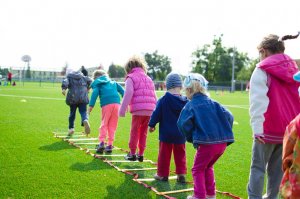There is so much writing, research, and advocacy happening lately to promote the role of physical activity and play in the school day.
In Virginia in the 2018 legislative session, we experienced an amazing achievement from the efforts of tireless parent advocates and state-level elected officials to pass a new recess law. I think the testimony from a local doctor – a mom, no less – sealed the deal, when she highlighted research showing that children’s brain are developing during free play time in recess, thus establishing recess as, in fact, instructional time. Children’s work is play.
 But even if it’s not free play, scheduled physical activity is proving its worth to help students develop healthy bodies and minds. I just learned about The Daily Mile, now in “3,600 primary schools each day in 35 countries around the world. It takes children outside during normal lesson time to run or walk laps of the playground for 15 minutes. The ones who run cover around a mile each day.”
But even if it’s not free play, scheduled physical activity is proving its worth to help students develop healthy bodies and minds. I just learned about The Daily Mile, now in “3,600 primary schools each day in 35 countries around the world. It takes children outside during normal lesson time to run or walk laps of the playground for 15 minutes. The ones who run cover around a mile each day.”
Researchers found that the Daily Mile is “definitely worthwhile – it increased moderate/ vigorous activity, decreased sedentary activity, made students “more awake, increased their attention and verbal memory, and improved their feelings of well-being.” And more.
Relatedly, I’m a big fan of Dr. John Ratey’s, especially his book, Exercise and the Brain, where the opening chapter chronicles students who exercised upon arriving at school (walking around the track). They then performed higher academically just after that exercise than those who were sedentary before starting their school day.
A parent recently asked my thoughts on the physical education curriculum in Fairfax County Public Schools, because she’d like to see instruction be more about physical fitness and meeting personal fitness goals that can be carried forward in life – rather than learning team sports that don’t interest her son, leaving him uninspired and left out. I responded that I’m eager to learn more about how to teach students daily fitness habits they can use for a lifetime.
 And, if physical health, mental alertness, and social inclusion aren’t reasons enough for you, how about considering the role of play and physical activity as a strategy for preserving our democracy? This NY Times opinion piece offers just that suggestion.
And, if physical health, mental alertness, and social inclusion aren’t reasons enough for you, how about considering the role of play and physical activity as a strategy for preserving our democracy? This NY Times opinion piece offers just that suggestion.
The science shows us it’s true; the kids’ performance shows us it’s true: we need to respect the biological development of students, and consider the physical experience in education.